
History and Customers
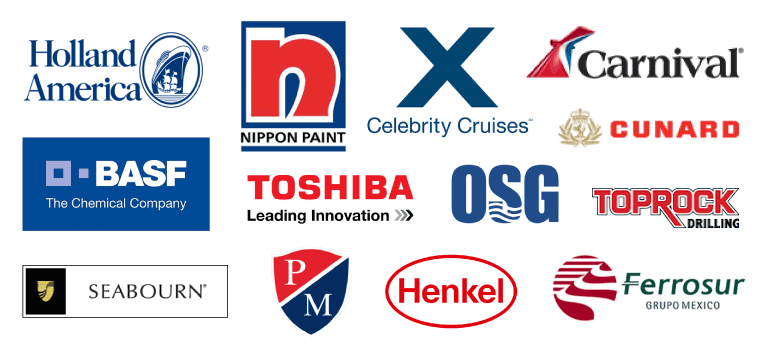
Nanovere Technologies specializes in the research, development and manufacturing of first-to-market nanocoatings with multi-functional properties. Nanovere was founded in 2003 by Thomas Choate. Twenty-one years earlier, Thomas began his scientific journey at the early age of 16 while working for Progressive Dental Laboratory in Brighton, MI. He began to develop skills in the art and science of manufacturing porcelain teeth (crowns), dental metallurgy, polymer synthesis, high heat ceramics and high heat porcelain glazes.
In 1986, Thomas founded Felix Dental Arts which focused on creating "life-like" dental prosthetics for local sport celebrities. In 1989, Felix Dental Manufacturing was founded with a focus on developing highly functional dental materials. Felix Dental developed the world's first polyurethane hybrid dental polymers with a thermal expansion of 0.05%, novel dental adhesives, super-hydrophobic coatings, silicone mold release agents and educational study models for dentists and dental technicians. Felix Dental was sold to American Dental Supply (ADS) in PA. ADS continues to market the Felix branded products including Plastical, Petrosil & Diax to leading dental laboratories, dentists and Dental Universities.
In 2003, Thomas founded Nanovere Technologies using key scientific concepts, materials and processes he invented for the dental industry. Nanovere began the development of highly scratch resistant, chemical and UV resistant nanocoatings with self-cleaning properties. The technical challenge was to develop multi-functional nanocoatings that would outperform "all" leading automotive and aerospace OEM coating competitors. After 5 years of extensive research and product development, Nanovere introduced the world's first Dendritic Polyurethane Coating systems in 2008. Nanovere began working closely with leading validation organizations including GM, Jaguar, BMW, Boeing, Club Car & Polaris.
In 2009, Nanovere began joint development efforts with Bayer MaterialSciences, Alcoa and Sveza Les OOO based in Russia. Nanovere's proprietary dendrimer based coating resins dramatically improve the overall physical properties of leading coating resins and formulated coating systems.
In 2011, Nanovere partnered with Nippon Paint in Asia under a global licensing agreement of Vecdor (CyGlaz) Dendrimers. Nippon is the largest paint manufacture in Asia. Today, Nippon manufactures and markets Nanovere's proprietary coating dendrimers to dramatically improve crosslink density, scratch resistance, chemical resistance and UV resistance within Nippon coating systems. Nippon markets the Nanovere dendrimer platform under the trade name CyGlaz.
In 2013, Nanovere introduced the world's first ambient cure Nano-Clear Coating platform to exceed automotive OEM, industrial and aerospace OEM technical specifications. The Nano-Clear product portfolio is manufactured by Nanovere in Brighton, Michigan and sold globally through select distributors.
Nano-Clear Coatings have been validated and in-use by leading chemical tank car manufactures, Toshiba Industrial Products, Sterling Crane, Nippon Paint, Carnival Cruise Lines, Queen Elizabeth & Queen Mary Cruise Lines, Princimar Chemical Carriers, OSG America...
Why Nano-Clear
What conventional paints fail?
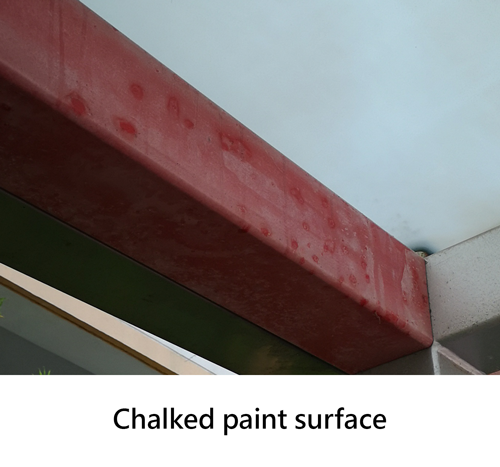

Painted surfaces are subject to UV degradation due to long-term exposure to sunlight, and from loss-of-gloss from chemical attack or micro-scratching due to repeated surface cleaning. The above problems are well-know to those in industries whose assets are regularly exposed to the envirnoment.
High valuel assets such as bridges, ships, cranes, tank cars and heavy duty machinery utilize conventional one- or two-component pigmental epoxy coatings for metal protection. These epoxy based coatings have excellent adhesion to metal with good "initial" corrosion resistance and "initial" surface hardness. Unfortunately epoxy based coatings fall short of areas of long-term UV and chemical resistance due to "poor cross-link density". Even with polyurethanes on top, they are still quite susceptible to corrosion or surface damage as the result of UV degradation, weathering, and for that matter, normal use. When these painted assets begin to degrade from the sun or chalk (due to poor corss-link density);the long-term corrosion resistance, chemical resistance, scratch resistance and clean-ablility are "adversely impacted". This surface chalking phenomenon is actually degraded paint that resides on the surface from UV exposure and weathering.
How Nano-Clear is different

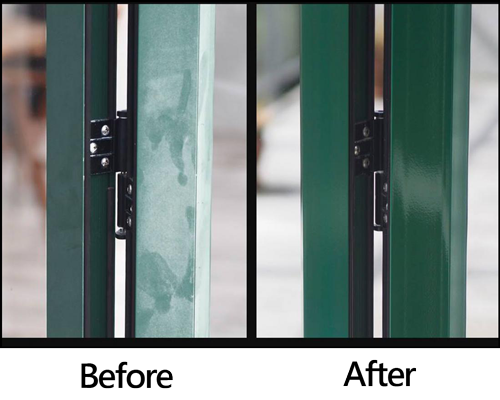
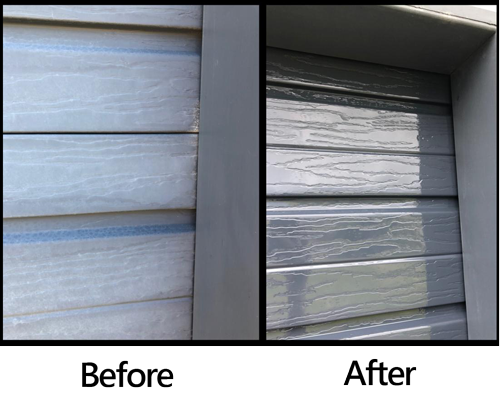
Nano-Clear Coatings penetrate deep into the smallest pores within newly painted or highly oxidized paint surfaces to form a highly cross-link dense / hard coat surface. Nano-Clear Coatings provide dramatically longer surface protection over conventional automotive, marine, aerospace and industrial paints including epoxies and polyurethanes. How can we make this claim? Nano-Clear Coatings provide dramatically higher crosslink density over conventional one-component and two-component coating systems. Nano-Clear Coatings prevent UV degradation of the substrate by absorbing harmful UV rays.
Crosslink density is defined as the concentration of chemical bonds within a polymer. Higher concentrations of chemical bonds within a polymer improve physical properties. Conversely, lower concentrations of chemical bonds within a polymer decrease physical properties. Increasing crosslink density increases material hardness, chemical resistance and long-term UV resistance.
Nano-Clear Coatings are manufactured using proprietary 3D nanostructured polymers. These 3D nano-scale molecular networks form the polymer backbone of all Nano-Clear Coating Systems. Dynamic Mechanical Thermal Analysis (DMTA) is utilized to calculate the "crosslink density" of coating polymers. Nano-Clear Coatings provide extreme crosslink density as measured using DMTA, including remarkable surface hardness, chemical resistance, extreme UV resistance.
Sumary of Nano Clear Properties
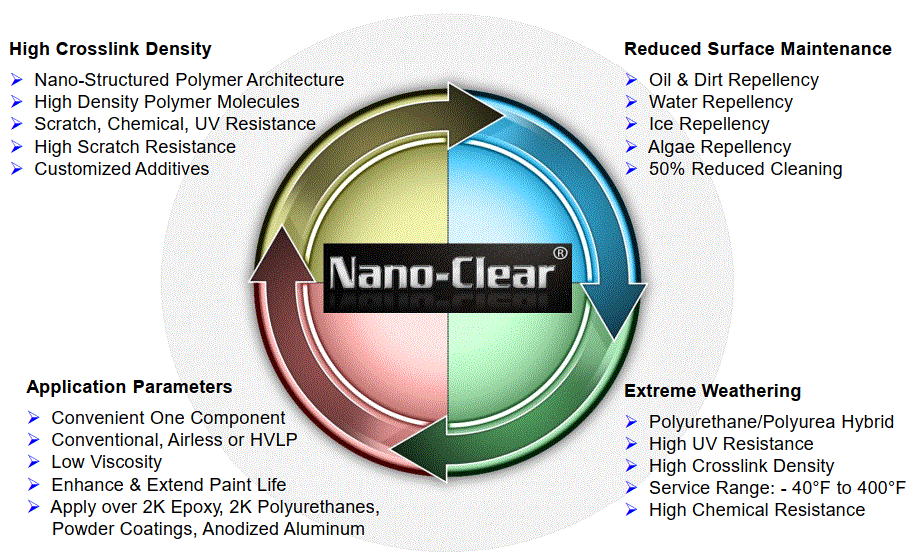
About Nano-Clear
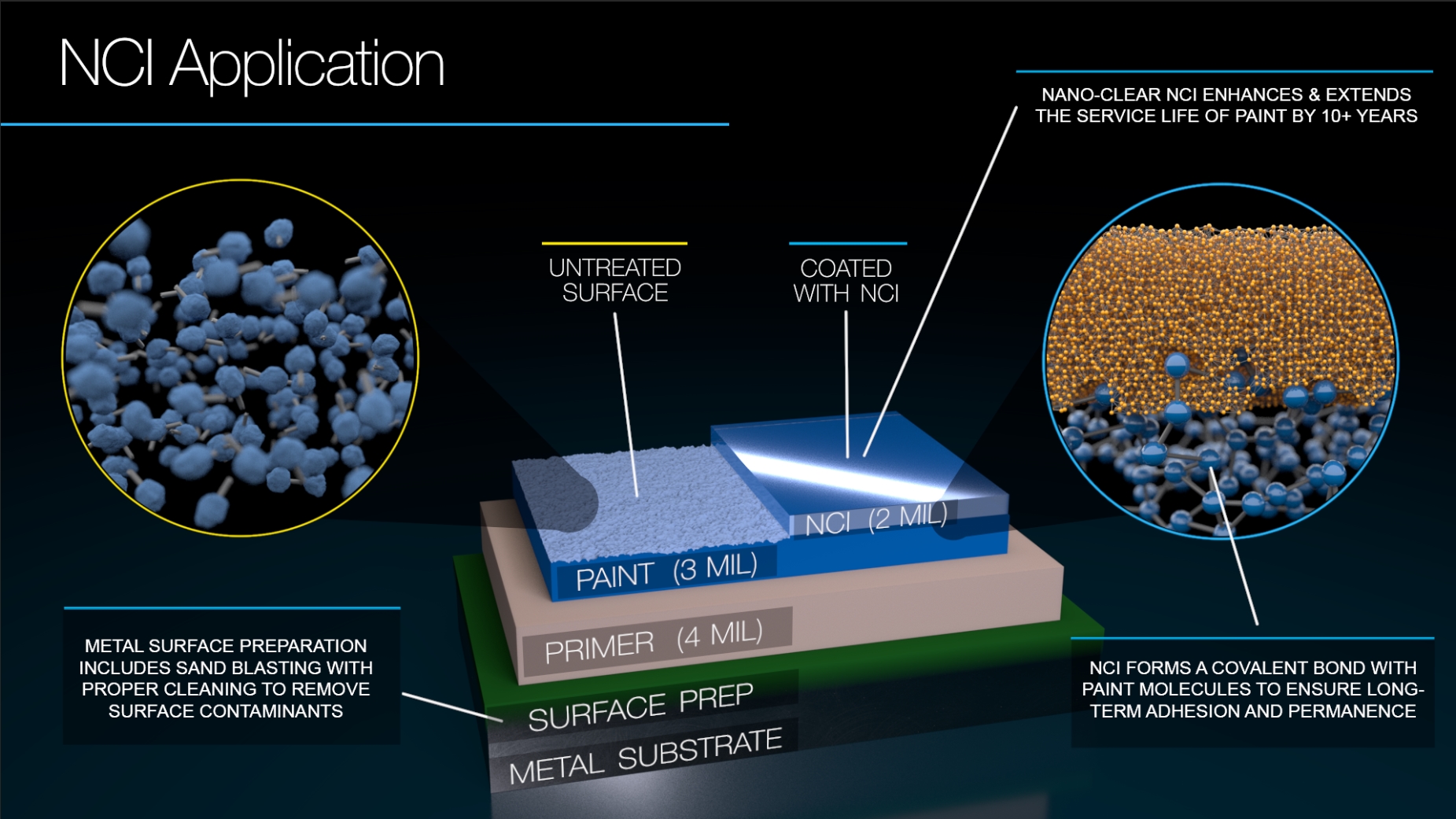
The automotive industry commonly applies high performance "clear topcoatings'" over painted surfaces to mitigate the negative effects of environmental exposure (acid rain, harsh UV rays, car washing, stone chips...). Automotive OEM clear coatings are well known to provide long-term surface protection against the environment when applied over painted surfaces. The industrial paint market currently relies on pigmented coatings alone without the use of a high performance clear coating. What is needed is a high performance clear coating designed to dramatically extend the surface life of industrial painted surfaces.
Nano-Clear® is designed to dramatically enhance and extend the surface life of "Newly Painted" or "Oxidized" painted surfaces by 10+ years. Organizations have invested billions of dollars to protect high-value assets from corrosion, scratching, chipping, chemical attack and weathering. Many of these assets were painted using inferior paint materials not designed to withstand long-term weathering and use. Organizations have various options when these painted assets degrade:
- Do nothing and allow the paint weathering cycle to continue (resulting in decreased corrosion, chemical and UV resistance).
- Replace the existing paint system using the same conventional systems (epoxy topcoat, polyurethane or latex).
- Enhance and extend the surface life of "New" or "Oxidized" painted assets by 10+ years using Nano-Clear®.
Conventional industrial paint systems including epoxies provide good corrosion resistance and initial surface hardness, but unfortunately fall short in long-term UV resistance and weathering. Two-component polyurethanes provide good UV resistance and weathering, but typically cost much more than epoxy or polyester topcoats. Unfortunately conventional paint systems like topcoats and epoxies begin the oxidization process or “chalking” from weathering within 6 months from application. This surface chalking phenomenon is actually degraded paint that resides on the surface from UV exposure and weathering.
Nano-Clear Coatings penetrate deep into the smallest pores within newly painted or highly oxidized paint surfaces to form a highly cross-link dense / hard coat surface. Nano-Clear Coatings provide dramatically longer surface protection over conventional automotive, marine, aerospace and industrial paints including epoxies and polyurethanes. How can we make this claim? Nano-Clear Coatings provide dramatically higher crosslink density over conventional one-component and two-component coating systems. Nano-Clear Coatings prevent UV degradation of the substrate by absorbing harmful UV rays.
What is crosslink density and why is it important in coatings? Crosslink density is defined as the concentration of chemical bonds within a polymer. Higher concentrations of chemical bonds within a polymer improve physical properties. Conversely, lower concentrations of chemical bonds within a polymer decrease physical properties. Increasing crosslink density increases material hardness, chemical resistance and long-term UV resistance.
How does crosslink density relate to a coatings longevity? High crosslink dense coatings provide increased molecular bonds. Increased molecular bonds are more difficult to break down by chemical attack, surface scratching and UV degradation from sunlight exposure. Highly crosslinked coatings provide increased physical performance and increased longevity as compared to lower crosslinked coating systems.
How is Nano-Clear Different? Nano-Clear Coatings are manufactured using proprietary 3D nanostructured polymers. These 3D nano-scale molecular networks form the polymer backbone of all Nano-Clear Coating Systems. Dynamic Mechanical Thermal Analysis (DMTA) is utilized to calculate the "crosslink density" of coating polymers. Nano-Clear Coatings provide extreme crosslink density as measured using DMTA, including remarkable surface hardness, chemical resistance, extreme UV resistance.
About Us

remarkable flexibility and self-cleaning properties.
Nanovere has developed a complete platform of market-ready 3D nanostructured polymers and multi-functional nanocoating formulations. Nano-Clear nanocoatings have been proven to be the most scratch, chemical and UV resistant in the coating industry. Nanovere has strategic relationships with end-use customers, paint manufactures, material suppliers and global distributors. Our business model supports the entire value chain through joint cooperation. Our 3D nanostructured coating polymers and nanocoating systems have been validated by global leaders in each industry we serve.
"Nanovere Technologies is dedicated to solving complex coating application issues as the world's leading developer of nanostructured multi-functional nanocoatings. Our success will be measured by our first-to-market approach, innovation focus, market share, value based partnership and customer referencing. We will only achieve these objectives through listening and quickly responding to the needs of our partners and customers".
Thomas Choate Founder & Chief Technology